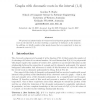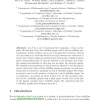117 search results - page 1 / 24 » Graphs with Chromatic Roots in the Interval (1, 2) |
COMBINATORICS
2007
13 years 4 months ago
2007
We present an infinite family of 3-connected non-bipartite graphs with chromatic roots in the interval (1, 2) thus resolving a conjecture of Jackson’s in the negative. In addit...
JCT
2007
13 years 4 months ago
2007
Let P(G,t) and F(G,t) denote the chromatic and flow polynomials of a graph G. D.R. Woodall has shown that, if G is a plane triangulation, then the only zeros of P(G,t) in (−∞...
CPC
2007
13 years 4 months ago
2007
Let P(G,t) and F(G,t) denote the chromatic and flow polynomials of a graph G. G.D. Birkhoff and D.C. Lewis showed that, if G is a plane near triangulation, then the only zeros of...
GD
2005
Springer
13 years 10 months ago
2005
Springer
Let S be a set of horizontal line segments, or bars, in the plane. We say that G is a bar visibility graph, and S its bar visibility representation, if there exists a one-to-one co...
EJC
2008
13 years 4 months ago
2008
The adaptable chromatic number of a graph G is the smallest integer k such that for any edge k-colouring of G there exists a vertex kcolouring of G in which the same colour never ...


